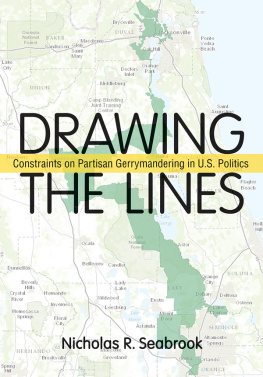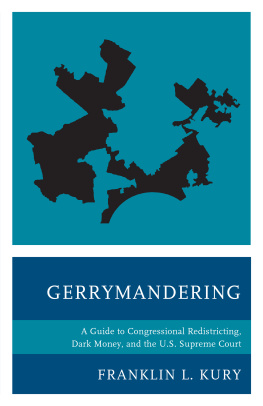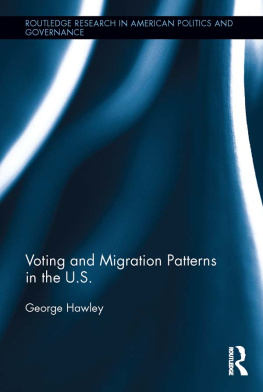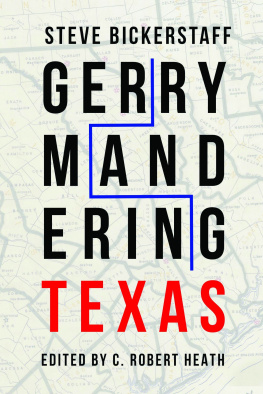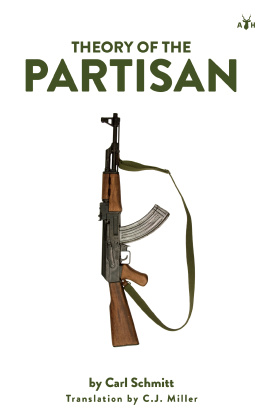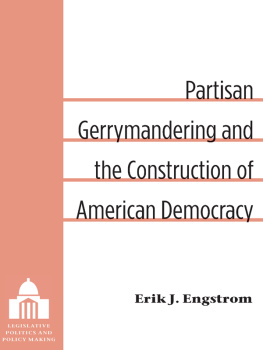INTRODUCTION
Perceptions and Misperceptions of Partisan Redistricting
As the results of the 2002 election flashed across their television screens, Texass congressional Republicans could be forgiven for feeling a certain amount of dissatisfaction with the redistricting process in the United States. Their party had seen its share of the statewide vote in U.S. House elections increase from 49.8 percent in 1992 to 54.9 percent in 2002. Yet, even with this latest ten-point victory over the Democrats in the popular vote, they had once again failed to convert their increasingly dominant electoral support into a Republican majority in the states congressional delegation. A partisan gerrymander, passed in the wake of the 1990 Census and left largely intact by the district boundaries implemented by the federal courts following the 2000 Census, had allowed the Democratic Party to maintain its overall majority in the Texas delegation for more than a decade. The Democrats won twenty-one of Texass thirty seats in Congress in 1992, and managed to retain control of nineteen in 1994 and seventeen from 1996 to 2000, despite averaging just 45.8 percent of the two-party vote in these elections. In 2003, the Texas Republicans, armed for the first time with control of both houses of the state legislature and the governorship, undertook an unprecedented mid-decade redrawing of the states congressional boundaries. Though many Republicans in the state government were opposed to the idea of redrawing the district boundaries mid-decade, the effort was initiated under considerable pressure from Republicans in Congress, most notably House majority leader Tom DeLay (Kang 2005).
When Governor Rick Perry called a special session of the legislature to draw up the new map, fifty-nine Democrats in the Texas House, many of whom fled the state across the Oklahoma border in order to avoid arrest, boycotted the session to deprive the Republicans of a quorum. A second special session produced another Democratic exodus: this time, eleven Democratic senators fled to New Mexico. The Republicans responded by deploying state troopers to try to apprehend and return the missing Democrats, and attempting to enlist the help of the Justice Department and the Federal Aviation Administration in order to locate them, for which DeLay was later reprimanded by the House Ethics Committee (Hefley and Mollohan 2004).
Eventually, after one of the recalcitrant Democrats returned to Austin, Governor Perry called a third special session and the bill was finally passed. This unusual step of undertaking a mid-decade redistricting was termed a perrymander, and the map itself was described by one journalist as resembling an attempt to diagram an oil spill using Legos (Ratliff 2003). Democrats decried the plan as an outrageous partisan power grab by iron-fisted far right-wing Republicans (Ratcliffe, Hughes, and Raskin 2003). Republicans hailed it as a historic advance in reorganizing government that was a real positive for the people of Texas (Blumenthal 2003). In the 2004 election held under the newly redrawn district boundaries, the Republicans won 59.7 percent of the two-party congressional vote in Texas and took control of the states delegation by a 2111 margin.
The Texas example illustrates not only how contentious partisan control of the redistricting process has become but also how debates over redistricting reform have been framed by a basic assumption that partisan gerrymandering is fundamentally and self-evidently undemocratic and undesirable. In the wake of the subsequent court challenge, editorials appeared in major newspapers with headlines such as Democracys Bad Week (St. Louis Post Dispatch, July 2, 2006), The Court to Democracy: Drop Dead (Chicago Tribune, July 2, 2006), and Texas Massacre (Boston Globe, June 29, 2006), while law review articles depicted the partisan gerrymander as a pervasive and ever-expanding enterprise (Katz 2007), and the Supreme Courts approach to redistricting litigation as no longer empirically valid today (Hirsch 2003). It is this level of conflict and controversy that has arisen in response to high-profile partisan gerrymanders and has seen the increasing involvement of the courts in redistricting litigation over the past several decades. The example of Texas is illustrative of a broader point: that the battle against partisan control of the redistricting process has been fierce, and it has been waged both in state legislatures and in the state and federal courts.
In reality, however, these efforts, though well-intentioned, are almost entirely misplaced. Effects attributed to partisan gerrymandering have been consistently demonstrated in the published political science literature to have mostly emanated not from deliberate manipulation of district boundaries, but instead from the natural impact of demographics and geography. As the Democratic Party has increasingly come to rely on urban and minority voters for its electoral coalition, their support has become more and more heavily concentrated in Americas cities. Meanwhile, Republican voters tend to be considerably more evenly dispersed throughout the suburbs, exurbs, and in rural areas. As Democratic candidates run up huge margins of victory in many of the districts they represent, their Republican counterparts have tended to win their seats by far less lopsided majorities. Excluding uncontested seats, in U.S. House elections between 1992 and 2010, there were 427 races in which the Democratic candidate won more than 75 percent of the two-party vote, compared to just 108 for the Republicans. Forty-two Democrats managed to capture a staggering 90 percent or more of the popular vote even when facing a Republican opponent, while just two Republicans were able to achieve the same feat. The result is that even when districts are drawn at random by computers, significant partisan bias still emerges, and producing a hypothetical unbiased set of electoral boundaries often requires far more egregious manipulation of districts than any partisan gerrymander. The energy, activism, and litigation currently directed at ending the practice of partisan gerrymandering would be much better invested in ensuring basic fairness and competitiveness in U.S. House elections. Far more pernicious than a single party using redistricting to gain an electoral edge is the much more widespread phenomenon of incumbent politicians drawing uncompetitive districts to insulate themselves against the voters. The effect of this practice is to significantly undermine democratic accountability. Only by emphasizing competitiveness in districting can we ensure that the results of congressional elections are genuinely responsive to the will of the people.
Negative Perceptions of Partisan Redistricting
Partisan gerrymandering has been a controversial topic in American politics throughout the nations entire political history. Critics of the practiceincluding many journalists (Chapman 2006; Economist 2002; Leavenworth 2010; Rosenbaum 2004), legal scholars (Dorf 2004; Greene 2005; Katz 2007; Lazarus 2003), and a number of political scientists (Grofman and King 2007; King et al. 2005)have attacked partisan redistricting as a significant threat to democracy. It is alleged that the effects of redistricting are large and enduring enough to effectively dictate future election outcomes, thus subverting the will of the electorate and significantly undermining political competition. Nevertheless, despite several protracted litigation battles, the Supreme Court has consistently declined to rule the practice unconstitutional.

